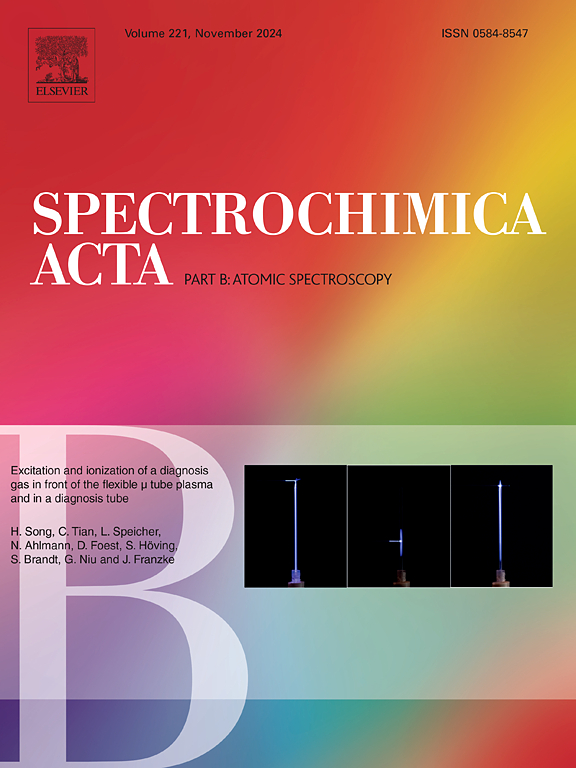银纳米颗粒污染土壤中次生Ag的性质分析
IF 3.2
2区 化学
Q1 SPECTROSCOPY
引用次数: 0
摘要
银纳米粒子(Ag₂S- nps)是污水污泥和被银纳米粒子(AgNPs)污染的土壤中的主要银种类。Ag+释放和纳米Ag₂S毒性的不确定性促使我们在现实条件下进一步研究Ag的形态和分布。在之前的研究中,我们通过体x射线吸收光谱(XAS)发现,污水污泥和土壤中除了存在Ag2S外,还存在次生AgS。该品种占总银的24 - 36%。本工作的目的是研究这种AgS的性质。结合Ag K和LIII边缘的微纳分辨率x射线吸收近边结构(XANES)光谱和S K边缘的微XANES。利用纳米x射线荧光(nXRF)研究了纳米颗粒的大小分布,并评估了混合金属硫化物的存在。我们鉴定出次生AgS是与有机物质的硫基结合的Ag (Ag-thiolate)。它存在于Ag2S-NPs周围,可能是由土壤有机质的硫基络合银+引起的。Ag2S-NPs显示出多种尺寸,10%至40%的颗粒在100 nm以下。混合金属硫化物也存在。本研究提高了我们对Ag- nps在陆地环境中的命运的认识,突出了Ag2S-NPs在土壤中的潜在反应性,并显示了土壤有机质作为释放Ag+的汇的主要作用。这种多尺度、高分辨率的方法代表了一种研究复杂环境矩阵中纳米颗粒行为的新颖而有力的方法。本文章由计算机程序翻译,如有差异,请以英文原文为准。

Deciphering the nature of secondary AgS species in soils polluted with Ag nanoparticles
Ag₂S nanoparticles (Ag₂S-NPs) are the main silver species in sewage sludge and soils polluted with silver nanoparticles (AgNPs). Uncertainties about Ag+ release and nano-Ag₂S toxicity prompted us to further investigate Ag speciation and distribution under realistic conditions. In a previous study we found by bulk X-ray absorption spectroscopy (XAS) that besides Ag2S, a secondary Ag![]() S species was present in sewage sludge and soils. This species accounted for 24–36 % of total silver. The objective of the present work was to investigate the nature of this Ag
S species was present in sewage sludge and soils. This species accounted for 24–36 % of total silver. The objective of the present work was to investigate the nature of this Ag![]() S species. A combination of X-ray absorption near edge structure (XANES) spectroscopy at Ag K and LIII edges at micro and nano resolutions and of S K-edge micro XANES were used. Nano X-ray Fluorescence (nXRF) was used to investigate the nanoparticle size distribution and to evaluate the presence of mixed metal sulfides. We identified the secondary Ag
S species. A combination of X-ray absorption near edge structure (XANES) spectroscopy at Ag K and LIII edges at micro and nano resolutions and of S K-edge micro XANES were used. Nano X-ray Fluorescence (nXRF) was used to investigate the nanoparticle size distribution and to evaluate the presence of mixed metal sulfides. We identified the secondary Ag![]() S species as Ag bound to thiol groups of organic matter (Ag-thiolate). It was present around the Ag2S-NPs, and likely resulted from the complexation of Ag+ by thiol groups of soil organic matter. Ag2S-NPs displayed a variety of sizes, with 10 % to 40 % of particles bellow 100 nm. Mixed metal sulfides were also present. This study improves our understanding of the fate of Ag-NPs in terrestrial environments, highlights the potential reactivity of Ag2S-NPs in soils, and shows the primary role of soil organic matter as a sink for released Ag+. This multi-scale, high-resolution approach represents a novel and powerful methodology for studying nanoparticle behavior in complex environmental matrices.
S species as Ag bound to thiol groups of organic matter (Ag-thiolate). It was present around the Ag2S-NPs, and likely resulted from the complexation of Ag+ by thiol groups of soil organic matter. Ag2S-NPs displayed a variety of sizes, with 10 % to 40 % of particles bellow 100 nm. Mixed metal sulfides were also present. This study improves our understanding of the fate of Ag-NPs in terrestrial environments, highlights the potential reactivity of Ag2S-NPs in soils, and shows the primary role of soil organic matter as a sink for released Ag+. This multi-scale, high-resolution approach represents a novel and powerful methodology for studying nanoparticle behavior in complex environmental matrices.
求助全文
通过发布文献求助,成功后即可免费获取论文全文。
去求助
来源期刊
CiteScore
6.10
自引率
12.10%
发文量
173
审稿时长
81 days
期刊介绍:
Spectrochimica Acta Part B: Atomic Spectroscopy, is intended for the rapid publication of both original work and reviews in the following fields:
Atomic Emission (AES), Atomic Absorption (AAS) and Atomic Fluorescence (AFS) spectroscopy;
Mass Spectrometry (MS) for inorganic analysis covering Spark Source (SS-MS), Inductively Coupled Plasma (ICP-MS), Glow Discharge (GD-MS), and Secondary Ion Mass Spectrometry (SIMS).
Laser induced atomic spectroscopy for inorganic analysis, including non-linear optical laser spectroscopy, covering Laser Enhanced Ionization (LEI), Laser Induced Fluorescence (LIF), Resonance Ionization Spectroscopy (RIS) and Resonance Ionization Mass Spectrometry (RIMS); Laser Induced Breakdown Spectroscopy (LIBS); Cavity Ringdown Spectroscopy (CRDS), Laser Ablation Inductively Coupled Plasma Atomic Emission Spectroscopy (LA-ICP-AES) and Laser Ablation Inductively Coupled Plasma Mass Spectrometry (LA-ICP-MS).
X-ray spectrometry, X-ray Optics and Microanalysis, including X-ray fluorescence spectrometry (XRF) and related techniques, in particular Total-reflection X-ray Fluorescence Spectrometry (TXRF), and Synchrotron Radiation-excited Total reflection XRF (SR-TXRF).
Manuscripts dealing with (i) fundamentals, (ii) methodology development, (iii)instrumentation, and (iv) applications, can be submitted for publication.

 求助内容:
求助内容: 应助结果提醒方式:
应助结果提醒方式:


